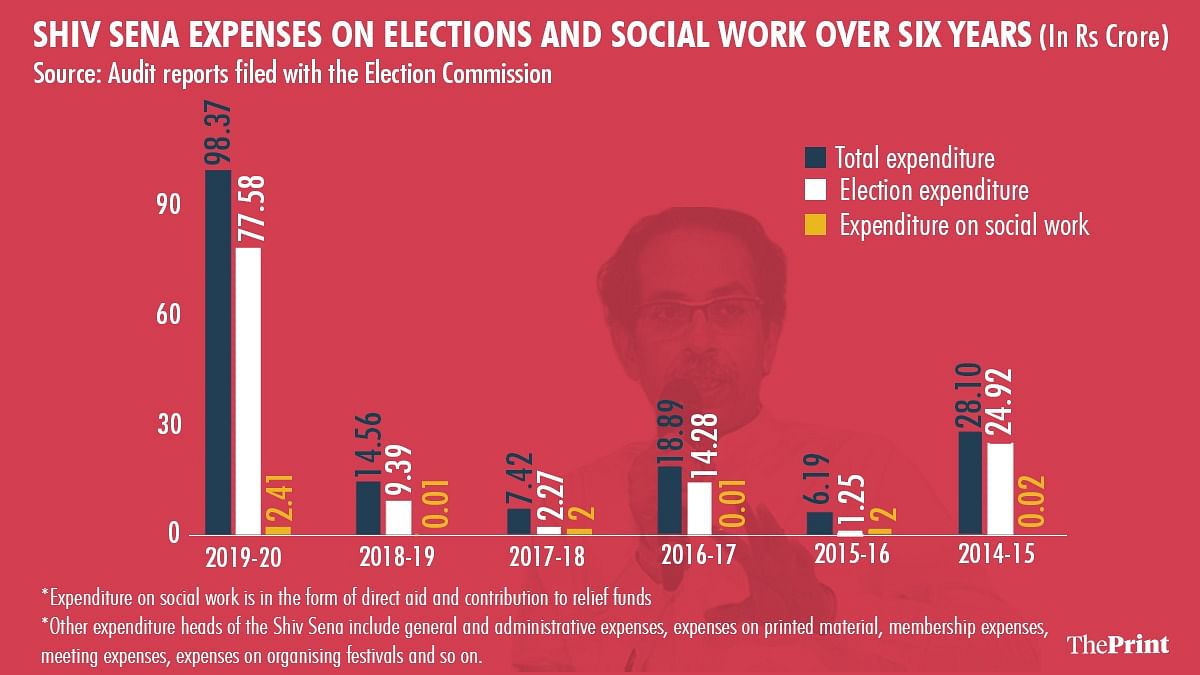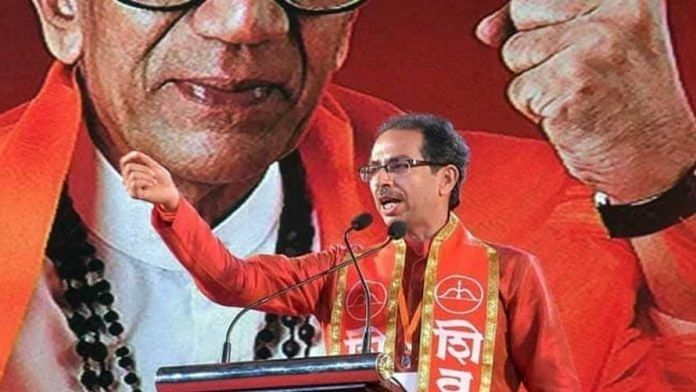Mumbai: When Bal Thackeray founded the Shiv Sena on 19 June 1966, he gave the party one slogan, “80 takke samajkaran, 20 takke rajkaran” (80 per cent social work, 20 per cent politics). As the party completes 55 years Saturday, it still insists that it runs on the same principle.
But, the party’s official expenditure over the past six years tells a different story.
ThePrint analysed the Shiv Sena’s audit reports filed with the Election Commission for the past six years to find that a majority of the party’s spending is focussed on elections. In five of these years, the Shiv Sena’s expenditure on elections outnumbered its spending on social work and was as high as 60-80 per cent of the party’s total spends in four years.
The Shiv Sena’s spending on social welfare was higher than its election expenses in just one of the six years, which was a non-election year. Even then, the Shiv Sena spent just about 32 per cent of its total central fund on social work, a far cry from Thackeray’s motto of 80 per cent social work.
Shiv Sena, led by Uddhav Thackeray, who is also Maharashtra’s chief minister, is known to be among the richest regional political parties in the country.
Party leaders say that the way the Sena spends its money should not be a measure of its social work and the party’s shakhas, its administrative units, at the grassroots, do a lot of public good.
Vinayak Raut, a senior Shiv Sena MP, told ThePrint, “The party’s central fund is just one aspect. Our shakhas exist with an obligation to focus on social work. Shiv Sena workers often spend out of their own pockets for this. Our shakhas did a lot of work during the Covid pandemic too. For example, in Mumbai itself during the first wave, Shiv Sainiks filled 56,500 bottles of blood.”
He added, “So, politics may be changing, but in Shiv Sena’s case, the 80 per cent samajkaran, 20 per cent rajkaran principle still holds true.”
Also read: Shiv Sena is in power, yet its 2019-20 donations are 20% less than what it got as BJP ally
Most of Shiv Sena’s money spent on elections
A majority of Shiv Sena’s funds are used to contest elections. For instance, in 2019-20, the year of two major polls — the 2019 Lok Sabha election and the state assembly poll later that year — the Sena spent Rs 77.58 crore — about 79 per cent of its total expenditure for the year of Rs 98.37 crore — on election expenses.

In terms of absolute numbers, this is the highest that the party has spent on fighting elections in the past six years.
In 2018-19, in the run-up to the 2019 polls, the party spent Rs 9.39 crore, or 64 per cent of its total spends of Rs 14.56 crore, on election-related expenses.
Similarly, in 2016-17, the year of civic polls in 10 of Maharashtra’s major cities, including the Shiv Sena’s home turf of Mumbai, the party spent Rs 14.28 crore, or about 75 per cent of the total Rs 18.89 crore, on elections. In 2014-15, the year of 2014 Lok Sabha and state assembly polls, the Shiv Sena spent Rs 24.92 crore, about 88 per cent of its overall expenditure of Rs 28.10 crore, on elections.
The only two years when the spend on polls was much lower were two non-election years — 2017-18, when the Shiv Sena had just retained power in major municipal corporations such as Mumbai and Thane and the parliament and assembly elections were still some time away; and in 2015-16, when the Shiv Sena had just joined hands with the Devendra Fadnavis-led BJP government in Maharashtra.
In 2015-16, the party spent Rs 1.25 crore out of a total spend of Rs 6.19 crore on election-related expenses, while in 2017-18, the election expenses were Rs 2.27 crore, about 30 per cent of the total Rs 7.42 crore.
Also read: Sena leader & ex-encounter cop hired ‘henchmen’ to kill Ambani case SUV owner, NIA claims
Expenditure on relief less than 1% for three of six years
In both 2015-16 and 2017-18, the spends on aid and relief work was higher than the other years. In its 2015-16 audit report, the Shiv Sena has classified the expense of Rs 2 crore as “madat” (aid). This accounts for about 32 per cent of the total expenditure for the year.
In the 2017-18 report, the party said that it donated Rs 2 crore to the Chief Minister Farmers’ Relief Fund and has another entry of Rs 10,000 as “madat”. Totally, this accounts for about 27 per cent of the Shiv Sena’s total expenditure for the year.
For the other years, the Shiv Sena’s spend on social work was less than three per cent — 2.4 per cent in 2019-20 when the party spent Rs 2.41 crore on aid to farmers and people affected by floods, and less than one per cent for the rest of the years, that is 2018-19, 2016-17 and 2014-15.
The Shiv Sena’s balance sheet includes an earmarked fund called a ‘madat nidhi’ (fund for aid), which has been Rs 1,30,43,995 for the last six years without any additions or deductions.
The audit reports for six years also show that the party has spent a sizable amount on celebrating festivals and holding meetings too. For four of the six years, the Shiv Sena spent more on festivals and meetings put together than it did on social work.
Over six years, the party has spent Rs 3.9 crore celebrating festivals and Rs 3.62 crore on meeting expenses.
Maharashtra BJP chief spokesperson Keshav Upadhye said, “Shiv Sena was known for its 80 per cent social work at one point of time. Where is it now? It doesn’t even seem to exist on paper.”
‘Party now has deep pockets, but social work has not evolved’
Like Raut, party MLC Manisha Kayande too defended the Shiv Sena saying its expenditure from its central fund, and work by its shakhas are distinct, and while the former focuses on election work and other expenses, the latter pushes the party’s social welfare agenda.
“People approach our shakhas for work related to the government, the civic body, the police, ration and several other reasons, and our shakha workers always help them. On our foundation day too, we have organised blood donation camps, distribution of food to those in the hospital, mass distribution of sanitisers, helping out with vaccination camps and so on,” Kayande said.
However, political analyst Hemant Desai said that though the party is richer, its outlook towards social work has not evolved.
Desai said that when Bal Thackeray founded the Shiv Sena, the party was hardly contesting elections for the first two decades, so all its non-election activities were termed as social work.
“This included giving free ambulance services, helping Marathi people get jobs whether by threat, intimidation or otherwise, organising blood donation camps, getting into trade unions, organising protests for various causes,” he said.
“Even today, Shiv Sena’s social work is, by and large, of a similar kind. With its funds, the Shiv Sena can take up investment-based social welfare projects. Aaditya Thackeray talks about environment as one of his pet agendas, so the party can use its funds to set up biogas plants or small sewage treatment plants. Or during Covid, the party could have set up a helpline system for relief, but it didn’t,” Desai said.
“The new leadership has not changed the outlook of the party towards social work,” he added.
Also read: BJP, Shiv Sena workers clash over ‘offensive’ Saamana editorial on Ram Mandir land deal



